Install the app
How to install the app on iOS
Follow along with the video below to see how to install our site as a web app on your home screen.
Σημείωση: This feature may not be available in some browsers.
You are using an out of date browser. It may not display this or other websites correctly.
You should upgrade or use an alternative browser.
You should upgrade or use an alternative browser.
Gigatronics (KAT computer)
- Έναρξη μίζας Nemo
- Ημερομηνία έναρξης
Captain Kal
RetroNuts!
- Joined
- 23 Δεκ 2006
- Μηνύματα
- 1.757
- Αντιδράσεις
- 238
billy
Retromaniax Co-Founder
- Joined
- 8 Ιαν 2006
- Μηνύματα
- 4.228
- Αντιδράσεις
- 282
Χαχαχαχα !! Ωραίος ο φίλτατος Captain. 
Nαί, σαν το γνωστό μας Γεράκι/Xωκ (αρχικά αντίπαλος, αλλά εν συνεχεία φίλος του Μπακ Ρότζερς).
btw, πριν πατήσω το link, νόμιζα ότι θα με οδηγούσες σε εικόνα με την εισαγωγική οθόνη του Falcon της Amiga
Nαί, σαν το γνωστό μας Γεράκι/Xωκ (αρχικά αντίπαλος, αλλά εν συνεχεία φίλος του Μπακ Ρότζερς).
btw, πριν πατήσω το link, νόμιζα ότι θα με οδηγούσες σε εικόνα με την εισαγωγική οθόνη του Falcon της Amiga
Τελευταία επεξεργασία από έναν συντονιστή:
Wally
Retired Admin
- Joined
- 19 Ιαν 2006
- Μηνύματα
- 26.042
- Αντιδράσεις
- 5.023
Επειδη τα posts ειναι πολλα, νομιζω πως στο Χριστουγεννιατικο τευχος του Phoenix θα κανουμε με το Γρηγορη ενα roundup με οτι εχουμε συλλεξει ως πληροφορια μεχρι τοτε.
Να ξανα-ευχαριστησω απο καρδιας τους ανθρωπους που μας δινουν πληροφοριες για το project.
Στο δι ταυτα τωρα...
Μας απεσταλλει μια διορθωση στη παρουσιαση που ειχε γινει στον KAT στο τευχος 8 και συναμα νεα δεδομενα που δεν γνωριζαμε (καποιες αναγκαστικα με αρκετα τεχνικους ορους):
Και ενα ενδεικτικο του σφοδρου αρνητικου κλιματος που αντιμετωπισε ο KAT εκεινη την εποχη ειναι και το παρακατω δημοσιευμα απο την Ελευθεροτυπια...

Να ξανα-ευχαριστησω απο καρδιας τους ανθρωπους που μας δινουν πληροφοριες για το project.
Στο δι ταυτα τωρα...
Μας απεσταλλει μια διορθωση στη παρουσιαση που ειχε γινει στον KAT στο τευχος 8 και συναμα νεα δεδομενα που δεν γνωριζαμε (καποιες αναγκαστικα με αρκετα τεχνικους ορους):
- H Gigatronics δεν κατασκευαζε switching τροφοδοτικά. Στα υπολοιπα μονο προϊόντα της εβαζε Linear τροφοδοτικά δικής της κατασκευής. Το συγκεκριμενο σχεδιαστηκε κατα παραγγελια και κατασκευαζοταν από την Ελληνική εταιρεια HYPERCON με εδρα την Καλλιθεα (την ειχαν δύο συνεταιροι ο Κος Βαλσαμοπουλος και καποιος αλλος)
- Τα chips με τα ταμπελακια PAL1,PAL2 ειναι Programmable Array Logic τυπου PAL16L8, PAL16R4, PAL16R6, PAL16R8. Μπηκαν για εξοικονομηση χωρου στην πλακετα καθώς αντικαθιστουν δεκαδες πυλες και Flip-Flops. Πχ στην περιπτωση RAS/CAS για τις dynamic μνήμες ή και του GCR για τις δισκέτες Apple. Η αναπτυξη γινoταν σε ABEL και ο προγραμματισμoς τους από ιδιοκατασκευη (που ισως μπορει να βρεθει!).
- Ολες τις μεταλλικες κατασκευες (κουτια - στηρίγματα κλπ) φτιαχνοντουσαν απο την RENTRON στη Κόρινθο (λειτουργει ακομα!)
- Η Gigatronics εν ετει 1988 ετοιμαζε τον διαδοχο του KAT που θα ανταγωνιζοταν τα IBM PS/2 και Aplle IIGS. Το project δεν ολοκληρωθηκε αλλα κατασκευαστηκαν δοκιμαστικες πλακετες. Ισως εχουμε νεα για την κατασταση τους συντομα
 ...
...
Και ενα ενδεικτικο του σφοδρου αρνητικου κλιματος που αντιμετωπισε ο KAT εκεινη την εποχη ειναι και το παρακατω δημοσιευμα απο την Ελευθεροτυπια...
angel_grig
KAT Resurrector
- Joined
- 11 Οκτ 2008
- Μηνύματα
- 3.150
- Αντιδράσεις
- 485
Mπραβο Πανο!Πολυ σημαντικες πληροφοριες!Εννοειται οτι θα γινει ενα νεο resume για το Χριστουγεννιατικο τευχος με οτι θα εχουμε μαθει εως τοτε,Για πες μας ομως περισσοτερα..Wally είπε:Επειδη τα posts ειναι πολλα, νομιζω πως στο Χριστουγεννιατικο τευχος του Phoenix θα κανουμε με το Γρηγορη ενα roundup με οτι εχουμε συλλεξει ως πληροφορια μεχρι τοτε.
Να ξανα-ευχαριστησω απο καρδιας τους ανθρωπους που μας δινουν πληροφοριες για το project.
Στο δι ταυτα τωρα...
Μας απεσταλλει μια διορθωση στη παρουσιαση που ειχε γινει στον KAT στο τευχος 8 και συναμα νεα δεδομενα που δεν γνωριζαμε (καποιες αναγκαστικα με αρκετα τεχνικους ορους):
- H Gigatronics δεν κατασκευαζε switching τροφοδοτικά. Στα υπολοιπα μονο προϊόντα της εβαζε Linear τροφοδοτικά δικής της κατασκευής. Το συγκεκριμενο σχεδιαστηκε κατα παραγγελια και κατασκευαζοταν από την Ελληνική εταιρεια HYPERCON με εδρα την Καλλιθεα (την ειχαν δύο συνεταιροι ο Κος Βαλσαμοπουλος και καποιος αλλος)
- Τα chips με τα ταμπελακια PAL1,PAL2 ειναι Programmable Array Logic τυπου PAL16L8, PAL16R4, PAL16R6, PAL16R8. Μπηκαν για εξοικονομηση χωρου στην πλακετα καθώς αντικαθιστουν δεκαδες πυλες και Flip-Flops. Πχ στην περιπτωση RAS/CAS για τις dynamic μνήμες ή και του GCR για τις δισκέτες Apple. Η αναπτυξη γινoταν σε ABEL και ο προγραμματισμoς τους από ιδιοκατασκευη (που ισως μπορει να βρεθει!).
- Ολες τις μεταλλικες κατασκευες (κουτια - στηρίγματα κλπ) φτιαχνοντουσαν απο την RENTRON στη Κόρινθο (λειτουργει ακομα!)
- Η Gigatronics εν ετει 1988 ετοιμαζε τον διαδοχο του KAT που θα ανταγωνιζοταν τα IBM PS/2 και Aplle IIGS. Το project δεν ολοκληρωθηκε αλλα κατασκευαστηκαν δοκιμαστικες πλακετες. Ισως εχουμε νεα για την κατασταση τους συντομα
...
Captain Kal
RetroNuts!
- Joined
- 23 Δεκ 2006
- Μηνύματα
- 1.757
- Αντιδράσεις
- 238
Κλασσική περίπτωση άρθρου, με "ελιτίστικη" διάθεση. Δεν τους άρεσε ο ΚΑΤ στα σχολεία, αλλά θα ικανοποιήθηκαν μάλλον που γέμισε ο κόσμος Hundai PC (με 8088) κάνα δυο χρόνια αργότερα.Και ενα ενδεικτικο του σφοδρου αρνητικου κλιματος που αντιμετωπισε ο KAT εκεινη την εποχη ειναι και το παρακατω δημοσιευμα απο την Ελευθεροτυπια...
angel_grig
KAT Resurrector
- Joined
- 11 Οκτ 2008
- Μηνύματα
- 3.150
- Αντιδράσεις
- 485
Πολυ σωστα!Αλλωστε και τα PS/2 που αναφερει το αρθρο-και αναφερομαι στα entry level μοντελλα- ηταν PC/XT χωρις να εχουν την περιφημη αρχιτεκτονικη microchannel της ΙΒΜ (που τελικα απετυχε) και ετσι δεν διεφεραν σε τιποτε απο ενα συμβατο.Εκτος του οτι στοιχιζαν την 4πλασια τιμη απο τον ΚΑΤ που ηταν 2 υπολογιστες σε εναν....Captain Kal είπε:Κλασσική περίπτωση άρθρου, με "ελιτίστικη" διάθεση. Δεν τους άρεσε ο ΚΑΤ στα σχολεία, αλλά θα ικανοποιήθηκαν μάλλον που γέμισε ο κόσμος Hundai PC (με 8088) κάνα δυο χρόνια αργότερα.
Wally
Retired Admin
- Joined
- 19 Ιαν 2006
- Μηνύματα
- 26.042
- Αντιδράσεις
- 5.023
Ενα αρθρο απο τους Financial Times 1 Νοεμβρη 1984 για την Gigatronics (Costis Stambolis) ειναι πλουσιο σε πληροφοριες. Το περασα απο OCR για να εχουμε αναζητησιμη πληροφορια. Επισυναπτω και το αρθρο (και ευχαριστω τον κυριο που μας τα παραχωρησε)
Η "Ευρωπη" (Europe) φερεται να ειναι το project που δουλευε ο κ Γεωργοπαπαδακος

Δηλαδη το 1984 η σειρα της Gigatronics αποτελουνταν απο τον Ερμη, G-200, Europe και ΕκατηIN LESS than four years since its incorporation, _ Gigatronics, the first and only Greek company to design and manufacture its own computer systems, has made considerable advances both in terms of hardware and software design. Company sources says, however, there has been very slow penetration in private and public sector markets.
Clients have been won slowly but consistently, however, and the list now includes the Public Power Corporation, several banks, the Ministry of Energy and shipping firms.
Penetrating the home market for a Greek company has been particularly difficult given the Greeks' general distrust of home made products. One of the key elements of the company's marketing strategy, points out Gigatronic's marketing director Mr Spyros Dikeopoulos, was the identification. at an early enough stage, of a specific niche for its products. These lay between the very simple and conventional applications served by the fast invading PC's, and highly complex applications which were more the domain of mainframe computers.
Gigatronics current range of products comprise three basic units depending on memory size and users "served. The smallest of the Gigatronic systems is called Hermes, after the Greek god of commerce and communications, and includes a VDU, a printer and a central memory unit whose capabilities range from a basic 64 Kb to 256 Kb.
Dr John Garyfallos, Gigatronic's director in charge of product planning, says that the Hermes unit was conceived right from the very beginning as a minicomputer suitable for Greece's great bulk of small and medium size companies whose average number of employees range from 10 to 40 people. " Being Greeks and having lived and worked in Greece for several years," says Garyfallos, " we think that we are in a much better position, compared to our competitors, to grasp the actual needs of the 100 thousand plus small industrial and commercial companies operating in Greece today. Their requirements call for a mini-type computer which can be expanded at little cost simply by the addition of more terminals."
Close co-operation with foreign suppliers is both inevitable and desirable, and we bear no grudges for it, say Gigatronics engineers involved with the design and production of the units at the company's manufacturing facility near Athens. The company recently established a close relationship with Newbury Data of the UK from whom they buy most of their discs.
Other vital components such as chips and VDUs are imported from abroad but the entire memory unit design and production is undertaken by Gigatronics — including all printed circuits.
Gigatronics now offers a larger system, the G-200, which is a direct development from Hermes. The G-20, which can take up to 16 terminals has already been put into use by bank and shipping clients.
A larger system, " Europe", has just been perfected and is geared exclusively for large corporate clients. One of Europe's important characteristics is its multi-cluster networking architecture. Each cluster behaves very much like an independent computer and can take up to 32 terminals.
But perhaps the most exciting of all Gigatronic products to date, notes Garyfallos, is the development of its own terminal display unit. Named Ekati, the name given to one of Moon's satellites, it is wholly designed and produced by Gigatronics.
Η "Ευρωπη" (Europe) φερεται να ειναι το project που δουλευε ο κ Γεωργοπαπαδακος
Μακαρι αν βρουμε κατι απο αυτα σε κατασταση που να μπορει με λιγη προσπαθεια απο μερους μας να λειτουργησει...georgopa είπε:Στην Gigatronics προσπάθησα να εργαστώ για την κατασκευή νέου interpreter BASIC βασισμένου στον μικροεπεξεργαστή Motorola 68000. Μέχρι τότε τα συστήματα της Gigatronics(interpreter BASIC,λειτουργικό σύστημα και βάση δεδομένων) ήταν γραμμένα στην γλώσσα του 8-bit μικροεπεξεργαστη 6502. Ο 68000 ήταν 16-bit και αυτό θα ήταν καλό για την εταιρεία. 'Ομως η προσπάθειά μου(την έκανα μόνος μου) δεν είχε αποτέλεσμα. Από ότι ξέρω η Gigatronics προχώρησε με τον 16-bit νέο 6502,που ήταν και συμβατός με τα προαναφερθέντα συστήματα.
Nemo
RetroMuseum GateKeepeR
- Joined
- 9 Ιαν 2006
- Μηνύματα
- 4.688
- Αντιδράσεις
- 1.455
Τιποτα οσο συνταρακτικο ,οσο τα τελευταια posts Wally .
Aπλα μια ακομα αναφορα στην Gigatronics του Καθηγητη Μ.Νικολικακου IMEO
(Ινστιτούτο Μελέτης της Ελληνικής Οικονομίας) για το
"Social Europe. Supplement
on NEW TECHNOLOGIES AND SOCIAL CHANGE OFFICE AUTOMATION
To σχετικο pdf βρισκεται εδω .
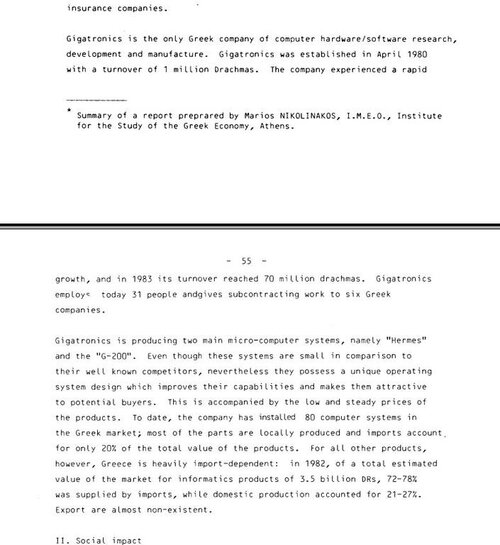
Nemo είπε:"Social Europe - Supplement
The software industry
(οσων αφορα το ελληνικο κομματι ειναι οπως γραφει συνοψη ενος απολογισμου του Καθηγητη Μ.Νικολικακου IMEO
(Ινστιτούτο. Μελέτης της Ελληνικής Οικονομίας )
To σχετικο pdf βρισκεται εδω
Aπλα μια ακομα αναφορα στην Gigatronics του Καθηγητη Μ.Νικολικακου IMEO
(Ινστιτούτο Μελέτης της Ελληνικής Οικονομίας) για το
"Social Europe. Supplement
on NEW TECHNOLOGIES AND SOCIAL CHANGE OFFICE AUTOMATION
To σχετικο pdf βρισκεται εδω .

Τελευταία επεξεργασία από έναν συντονιστή:
Wally
Retired Admin
- Joined
- 19 Ιαν 2006
- Μηνύματα
- 26.042
- Αντιδράσεις
- 5.023
Να σαι καλα Nemo για τις ανασκαφες!!
Συλλεξαμε καποιες πληροφοριες μεσω emails και διασταυρωσεων και ειμαστε σε θεση να κανουμε ενα μικρο χρονολογιο του πως εγινε η ιδρυση της Gigatronics (το κάνω επίσημο, βάζω και τόνους )
)
Η Γιγατρόνικς ΕΠΕ δεν ξεκίνησε από το πουθενά...
Πριν το 1977 υπήρχε μία εταιρεία με την επωνυμία HARDSOFT που είχε το εργαστήριο της σε ένα υπόγειο στην περιοχή Ζωγράφου.
Αναμεσα στους ιδιοκτήτες ηταν:
Σε εκεινη περίπου την περίοδο προσλήφθηκε στην εταιρεία και ο Γιώργος Χρόνης όπου εκείνη την εποχή έκανε πτυχιακή εργασία στο Φυσικό με τον Κωσταράκη (εφτιαχναν controllers για ένα σύστημα CAMAC που διέθετε το πανεπιστήμιο) και έτσι έμαθε για την HARDSOFT και ακολούθησε.
Στην HARDSOFT είχαν κάποιες πλακέτες της OHIO SCIENTIFIC και με αυτές είχαν στήσει συστήματα Η/Υ τα οποία αντί για monitor είχαν τηλεόραση. Με την βοήθεια αυτών των υπολογιστών μέσα σε λίγο καιρό αναπτύχθηκε hardware και software με δικό τους know-how.
Τότε η εταιρία δεν πούλαγε σχεδόν τίποτα. Το μοναδικό έσοδο ήταν από κάτι ηλεκτρονικές αναφλέξεις για αυτοκίνητα
Κάποια στιγμή τα πράγματα είχαν ωριμάσει και άρχισε η αναζήτηση συνεταίρου-επενδυτή.
Παράλληλα εκείνη την εποχή υπήρχε στον Πειραιά η FORMORE που έκανε μηχανογραφήσεις. Είχαν ένα σύστημα της DATA POINT. Μεταξύ των συνεταίρων και ο Γιάννης Γαρύφαλλος ο οποίος απο τότε ήθελε να φτιάξει database αλλά η DATAPOINT δεν είχε τέτοιες βλέψεις εκείνη την εποχή.
Με κάποιο τρόπο (η αγορά ήταν πολύ μικρή τότε) έμαθε για την ύπαρξη της HARDSOFT και έγινε το πάντρεμα των δύο εταιρειών και δημιουργήθηκε η Γιγατρονικς ΕΠΕ...
Σε ελάχιστο διάστημα το GIGA database ήταν πραγματικότητα (ιδέα του Γ. Γαρύφαλλου που υλοποίησε σε assembly ο Α. Μηλατος)
Αυτααααααάαααααααα
Συλλεξαμε καποιες πληροφοριες μεσω emails και διασταυρωσεων και ειμαστε σε θεση να κανουμε ενα μικρο χρονολογιο του πως εγινε η ιδρυση της Gigatronics (το κάνω επίσημο, βάζω και τόνους
Η Γιγατρόνικς ΕΠΕ δεν ξεκίνησε από το πουθενά...
Πριν το 1977 υπήρχε μία εταιρεία με την επωνυμία HARDSOFT που είχε το εργαστήριο της σε ένα υπόγειο στην περιοχή Ζωγράφου.
Αναμεσα στους ιδιοκτήτες ηταν:
- O Παν. Κωσταράκης (τώρα καθηγητής στο πανεπιστήμιο Ιωαννίνων ) που τότε ήταν βοηθός στο Φυσικό τμήμα του Πανεπιστήμιου Αθηνών (καθηγητής Ρεσβάνης). Ο Π. Κωσταράκης ήταν προηγούμενως στο Fermi lab στη Αμερική και στο CERN. Είχε ασχοληθεί πολύ με ηλεκτρονικά στα δύο αυτά κέντρα. Επίσης στην Αμερική είχε δει πολλά που αφορούσαν Η/Υ.
- Ο Αντώνης Μηλάτος-Ρούφος επίσης φυσικός με ταλέντο στο software.
- Ο Γιάννης Ανυφαντής που ήταν ηλεκτρονικός
Σε εκεινη περίπου την περίοδο προσλήφθηκε στην εταιρεία και ο Γιώργος Χρόνης όπου εκείνη την εποχή έκανε πτυχιακή εργασία στο Φυσικό με τον Κωσταράκη (εφτιαχναν controllers για ένα σύστημα CAMAC που διέθετε το πανεπιστήμιο) και έτσι έμαθε για την HARDSOFT και ακολούθησε.
Στην HARDSOFT είχαν κάποιες πλακέτες της OHIO SCIENTIFIC και με αυτές είχαν στήσει συστήματα Η/Υ τα οποία αντί για monitor είχαν τηλεόραση. Με την βοήθεια αυτών των υπολογιστών μέσα σε λίγο καιρό αναπτύχθηκε hardware και software με δικό τους know-how.
Τότε η εταιρία δεν πούλαγε σχεδόν τίποτα. Το μοναδικό έσοδο ήταν από κάτι ηλεκτρονικές αναφλέξεις για αυτοκίνητα
Κάποια στιγμή τα πράγματα είχαν ωριμάσει και άρχισε η αναζήτηση συνεταίρου-επενδυτή.
Παράλληλα εκείνη την εποχή υπήρχε στον Πειραιά η FORMORE που έκανε μηχανογραφήσεις. Είχαν ένα σύστημα της DATA POINT. Μεταξύ των συνεταίρων και ο Γιάννης Γαρύφαλλος ο οποίος απο τότε ήθελε να φτιάξει database αλλά η DATAPOINT δεν είχε τέτοιες βλέψεις εκείνη την εποχή.
Με κάποιο τρόπο (η αγορά ήταν πολύ μικρή τότε) έμαθε για την ύπαρξη της HARDSOFT και έγινε το πάντρεμα των δύο εταιρειών και δημιουργήθηκε η Γιγατρονικς ΕΠΕ...
Σε ελάχιστο διάστημα το GIGA database ήταν πραγματικότητα (ιδέα του Γ. Γαρύφαλλου που υλοποίησε σε assembly ο Α. Μηλατος)
Αυτααααααάαααααααα
angel_grig
KAT Resurrector
- Joined
- 11 Οκτ 2008
- Μηνύματα
- 3.150
- Αντιδράσεις
- 485
Πολυ καλες πληροφοριες Πανο!!Ευχαριστουμε πολυ αυτους που τις προσεφεραν!!
Nemo
RetroMuseum GateKeepeR
- Joined
- 9 Ιαν 2006
- Μηνύματα
- 4.688
- Αντιδράσεις
- 1.455
http://www.hpdst.gr/system/files/abacus-catalogue.pdf_0.pdf
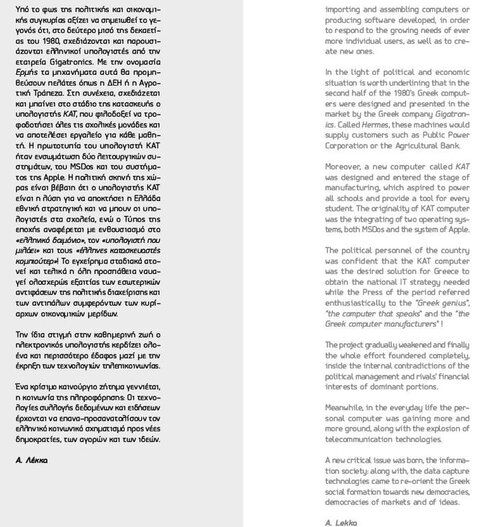 http://www.hpdst.gr/system/files/abacus-catalogue.pdf_0.pdf
http://www.hpdst.gr/system/files/abacus-catalogue.pdf_0.pdf
Απο το Pdf με προέλευση την
Εκθεση "Αβαξ: Πλευρές της ιστορίας των υπολογιστών στην Ελλάδα"
και σχετικο thread
 http://www.hpdst.gr/system/files/abacus-catalogue.pdf_0.pdf
http://www.hpdst.gr/system/files/abacus-catalogue.pdf_0.pdfΑπο το Pdf με προέλευση την
Εκθεση "Αβαξ: Πλευρές της ιστορίας των υπολογιστών στην Ελλάδα"
και σχετικο thread
Nemo
RetroMuseum GateKeepeR
- Joined
- 9 Ιαν 2006
- Μηνύματα
- 4.688
- Αντιδράσεις
- 1.455
Wally είπε:Πριν το 1977 υπήρχε μία εταιρεία με την επωνυμία HARDSOFT που είχε το εργαστήριο της σε ένα υπόγειο στην περιοχή Ζωγράφου.
Αναμεσα στους ιδιοκτήτες ηταν:
- O Παν. Κωσταράκης (τώρα καθηγητής στο πανεπιστήμιο Ιωαννίνων ) που τότε ήταν βοηθός στο Φυσικό τμήμα του Πανεπιστήμιου Αθηνών (καθηγητής Ρεσβάνης). Ο Π. Κωσταράκης ήταν προηγούμενως στο Fermi lab στη Αμερική και στο CERN. Είχε ασχοληθεί πολύ με ηλεκτρονικά στα δύο αυτά κέντρα. Επίσης στην Αμερική είχε δει πολλά που αφορούσαν Η/Υ.
- Ο Αντώνης Μηλάτος-Ρούφος επίσης φυσικός με ταλέντο στο software.
- Ο Γιάννης Ανυφαντής που ήταν ηλεκτρονικός
Στην HARDSOFT είχαν κάποιες πλακέτες της OHIO SCIENTIFIC και με αυτές είχαν στήσει συστήματα Η/Υ τα οποία αντί για monitor είχαν τηλεόραση. Με την βοήθεια αυτών των υπολογιστών μέσα σε λίγο καιρό αναπτύχθηκε hardware και software με δικό τους know-how.
.....
Αυτααααααάαααααααα
Nα συμπληρωσω οτι η Hardsoft ανεπτυξε πρωτοποριακο software για το T.Intruments TI59 προγραμματιζομενο calculator,το οποιο χρησιμοποιηθηκε απο συγκεκριμμενο κρατικο φορεα και μαλιστα
βραβευτηκε απο τον υπουργο στον οποιο υπαγοταν ο συγκεκριμμενος κρατικος φορεας ....
Nemo
RetroMuseum GateKeepeR
- Joined
- 9 Ιαν 2006
- Μηνύματα
- 4.688
- Αντιδράσεις
- 1.455
Απο την ΣΥΝΕΝΤΕΥΞΗ:Αντώνης Μηλάτος / Phoenix 9
Σε λίγο καιρό θα δείτε και παρουσίαση του Foun-
dation μέσα από το Retromaniax
Δεν το πιστεύω! Είστε πολύ καλοί. Το Foundation
ήταν εξαιρετικό πρόγραμμα. Πολύ ταχύτερο από οτι-
δήποτε αντίστοιχο κυκλοφορούσε σε Apple εκείνη την
εποχή, ακόμα και το AppleWorks. Γραμμένο εξ ολο-
κλήρου σε assembly. Βλέπεις τα δημοσιεύματα. Έτος
1987 και στα 12000 software, είμαστε μέσα στα 100.
....
Stanley Goldberg αλλά σύντομα δυστυχώς
πήραν τα μυαλά του αέρα και νόμισε ότι χωρίς τη βοή-
θεια του κατασκευαστή θα μπορούσε να κάνει δουλειά.
Βρήκε κάτι τεχνικούς, έγραψε κάτι μετριότατα εγχειρίδια
αλλά αν δεν έχεις manuals, υποστήριξη, διαδικασίες
για bug fixing δεν προχωράς πουθενά πόσο μάλλον
στις ΗΠΑ. Κρίμα διότι ήταν φοβερό application.
Αναφορες στo ανταγωνιστικο του AppleWorks λογισμικο της Gigatronics ``Foundation``
>>>>> http://articles.chicagotribune.com/1986-11-03/business/8603220626_1_lab-firm-lab-founder-apple-ii-lineHard Times For Ex-software King
Micro Lab Founder: Industry Has Less Room For Little Guy
November 03, 1986
....................................
But, as is often the case in the world of high-tech, his fall was almost as sudden as his climb. By spring of 1985, Micro Lab was under Chapter 11 bankruptcy protection, with $3.5 million in debts and $900,000 in assets.
Goldberg blamed the changing marketplace. Once he recognized that business software was the area he should be emphasizing, he couldn`t afford to develop programs, he said.
Micro Lab did come out with a program called Tax Manager, which sold more than 35,000 copies, but it couldn`t offset the damage done by his concentration on Colecovision cartridges when that industry began to wane.
``I always wonder what I could have done if Micro Lab hadn`t been so undercapitalized,`` he said.
Goldberg is trying to pick up the pieces, this time with ``Foundation,``
an integrated word processing, relational database and spreadsheet program for the the Apple II line. He also plans to produce it for IBM-compatible machines.
But he is finding it difficult to attract lightning twice, and impossible to get venture capital. He and partner Claudette Mauro are financing his new operation.
A stack of packages with ``Foundation`` printed on them sits in a corner of his Near North Side town house, his base of operations. On the coffee table nearby sit flashy Entrepreneur of the Year and Small Business awards he won when Micro Lab was flourishing.
Goldberg drove to 300 retailers across the country to demonstrate his product but found that the retail industry has changed dramatically in a year and a half.

Though he said he got 150 outlets to carry Foundation, which sells for $250, it was much harder than in the past.
``There`s a shrinking dealer base, and the kind of service they provide has changed.
``Today`s dealers are into `moving boxes.` They want to sell hardware, not software. They aren`t interested in supporting their software sales, or putting up with all the grief involved in baby-sitting new users,`` he said. Goldberg maintains that because of all the discounting in the computer industry, margins have changed, and the better, more aggressive salespeople in many cases have moved into other industries. So, retailers are seeking a simpler sales approach, which leaves out new, unknown software programs.
Goldberg said he has uncovered a reservoir of good will here and there;
dealers who remembered Micro Lab and were willing to listen to his spiel because of good support in the past.
But in his travels, he said, he also has run into dealers who were ``just plain nasty,`` who would turn him over to their high school whiz kid assistants or go down the street for cigarettes during his demonstration.
``Dealers have seen everything these days, and they are extremely skeptical. You can`t just send them a program, you have to go in and show it to them yourself, or they won`t even look at it. Even then, some of them won`t even look at it.
If Foundation could catch just ``a respectable percentage`` of the 175 millionAppleworks sales, a program that Foundation resembles in some ways, Goldberg would be happy. His first year goal is to get a ``representative foothold in the business community.``
Goldberg said he is trying to work closely with users groups, which are notorious for trading copies of programs back and forth and teaching other members how to use them.
``I am talking to some of them, and making agreements to provide support and back-up to them at no charge, and in exchange, they are promising not to help those who don`t buy the program,`` he said.
Looking back on his career, Goldberg concluded that the ups and downs are part of entrepreneurship.
``However, I wouldn`t want to go through that again,`` he said of the stressful period in which is his company--and his marriage--went under. ``It was very painful. But on the whole, I feel that the computer industry has been good to me.`
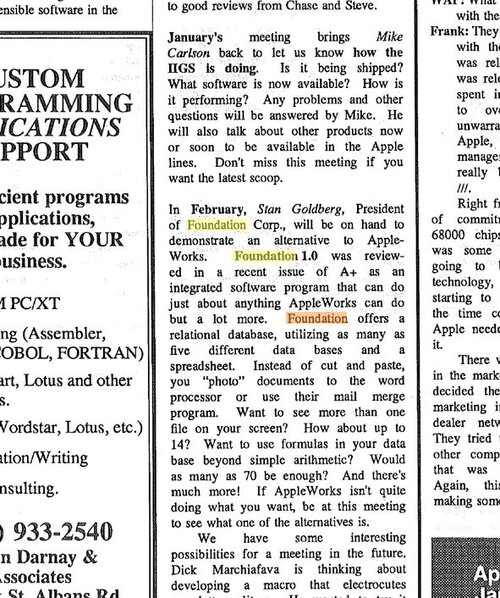
https://docs.google.com/viewer?a=v&q=cache:5KnThvGwxZkJ:ftp://208.185.231.250/pub/apple_II/documentation/magazines/miniapples/miniapples_v10n01_1987-01.pdf+Stanley+Goldberg+,AppleWorks,Foundation&hl=el&gl=gr&pid=bl&srcid=ADGEEShgYWSL-ii9uyDPLPeeBtxPkIvjlwLvhOblQ4aQppVTT7gIQ578tgGu2otO_Ofz_s_RzMwLWvewuSR2VrR6CUoOavA4gNDpblh4D_FteOkf4OCR6RXMZ5udH2F_YxIYkg7lJ6On&sig=AHIEtbTYTDIstSoch3y_Ps8DVxZaSCg8IQ
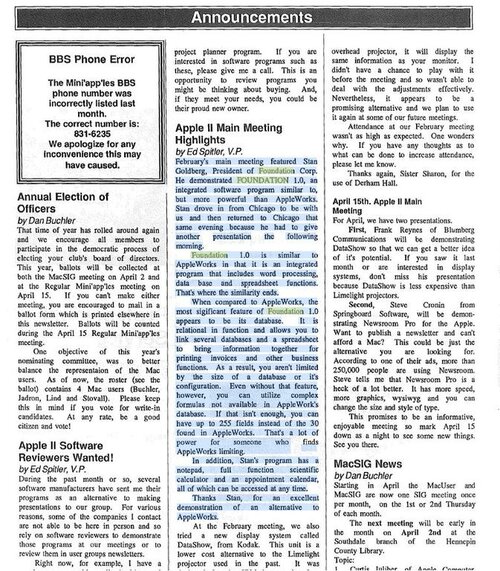
https://docs.google.com/viewer?a=v&q=cache:bwUPIe-KWhUJ:ftp://208.185.231.250/pub/apple_II/documentation/magazines/miniapples/miniapples_v10n04_1987-04.pdf+Stan+Goldberg,AppleWorks+alternative+,Apple+II&hl=el&gl=gr&pid=bl&srcid=ADGEEShSiaXWSUbwA0xIDA9ySShNwd_MsgiRPTizzb5XQnCt0_Hpk4Bw2Um1NB25MuWByHJVruBxwfjhisEUHkLk_BkLgsGlvdAcG70rgy3ni7iMAcAFJBfGGu5F4hjwluO_SVKnOR_S&sig=AHIEtbQxN18W79kMfhVuwWom9EZMuKg7uA
Τελευταία επεξεργασία από έναν συντονιστή:
Nemo
RetroMuseum GateKeepeR
- Joined
- 9 Ιαν 2006
- Μηνύματα
- 4.688
- Αντιδράσεις
- 1.455
Απο την ΣΥΝΕΝΤΕΥΞΗ:Αντώνης Μηλάτος / Phoenix 9
Σε λίγο καιρό θα δείτε και παρουσίαση του Foun-
dation μέσα από το Retromaniax
Δεν το πιστεύω! Είστε πολύ καλοί. Το Foundation
ήταν εξαιρετικό πρόγραμμα. Πολύ ταχύτερο από οτι-
δήποτε αντίστοιχο κυκλοφορούσε σε Apple εκείνη την
εποχή, ακόμα και το AppleWorks. Γραμμένο εξ ολο-
κλήρου σε assembly. Βλέπεις τα δημοσιεύματα. Έτος
1987 και στα 12000 software, είμαστε μέσα στα 100.
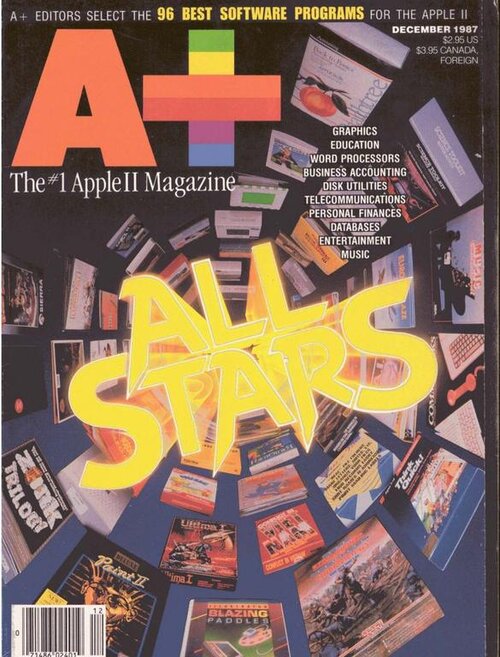
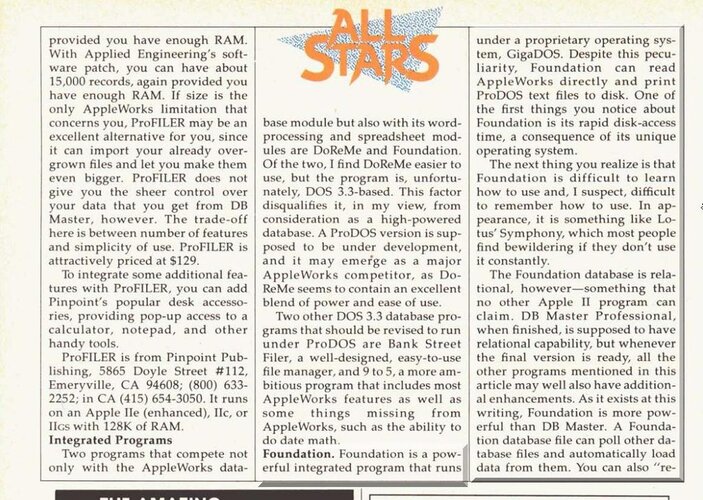
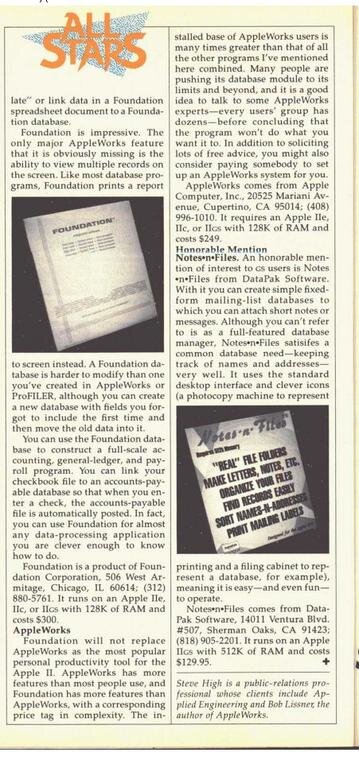
Α+ Δεκεμβριος 1987 σελιδες 108 & 110
Τελευταία επεξεργασία από έναν συντονιστή:
angel_grig
KAT Resurrector
- Joined
- 11 Οκτ 2008
- Μηνύματα
- 3.150
- Αντιδράσεις
- 485
Μετά από αρκετό καιρό επανερχόμαστε στο thread του ΚΑΤ γιατί φυσικά έχουμε νεότερα…Αν θυμάστε, στο προτελευταίο τεύχος του phoenix ,είχαμε πει ότι αυτό που εκκρεμούσε, για να ολοκληρωθεί το emulation σε IBM mode ,ήταν το πλήρες αντίγραφο της ROM από την CGA.To βασικό μειονέκτημα ήταν φυσικά ότι δεν μπορούσαμε να γράψουμε Ελληνικά στον emulator.Μετά από την σχετική έρευνα ανακάλυψα ότι το τμήμα της ROM που περιέχει τους Ελληνικούς χαρακτήρες δεν μπορούμε να το αντιγράψουμε ούτε μέσω κάποιου προγράμματος, αλλά ούτε και με το debug. 
Eπομένως η μόνη επιλογή που έμενε ήταν ο hardware τρόπος, δηλ. η σύνδεση του chip σε έναν EPROM programmer…Επειδή όμως δεν τα παρατάμε εύκολα (και αφού το google είναι φίλος μας ) βρήκα ότι παρʼόλο που δεν μπορούμε να κάνουμε copy την ROM, μπορούμε ωστόσο να δημιουργήσουμε ένα ακριβές αντίγραφο!!! :wait2:
) βρήκα ότι παρʼόλο που δεν μπορούμε να κάνουμε copy την ROM, μπορούμε ωστόσο να δημιουργήσουμε ένα ακριβές αντίγραφο!!! :wait2:
Και επειδή έχει αρχίσει το πράγμα να γίνεται… κουλτουριάρικη ταινία, ας εξηγηθώ καλύτερα:
Πηγαίνουμε στο ακόλουθο site http://www.seasip.demon.co.uk/Unix/PSF/ripfont.html και κατεβάζουμε το προγραμματάκι Ripfont.exe.Εκτός από αυτό χρειαζόμαστε και το Graphtabl του DOS. Εγω είχα την έκδοση για DOS 3.30 η οποία όμως ΔΕΝ είναι συμβατή με το DOS 3.20:rant:..επειδη λοιπόν και οι Ρώσοι είναι φίλοι μας , με μια βόλτα σε ένα ρωσικό site πήρα την έκδοση για DOS 3.20.Περνάμε λοιπόν τα 2 αυτά προγράμματα σε μια δισκέττα των 5,25 και ξεκινάμε τον ΚΑΤ…
, με μια βόλτα σε ένα ρωσικό site πήρα την έκδοση για DOS 3.20.Περνάμε λοιπόν τα 2 αυτά προγράμματα σε μια δισκέττα των 5,25 και ξεκινάμε τον ΚΑΤ…
Το Ripfont είναι ουσιαστικά ένας font editor.Mε το πρόγραμμα αυτό παίρνουμε έναν-έναν τους χαρακτήρες και τους τροποποιούμε ώστε να γίνουν όπως τους θέλουμε (δηλ. Ελληνικοί).Το πλεονέκτημα του προγράμματος είναι ότι όσο τροποποιούμε τον χαρακτήρα μπορούμε να τον δούμε πως είναι στην ROM ώστε να τον κάνουμε ίδιο..
To set χαρακτηρων που απο ετσι....
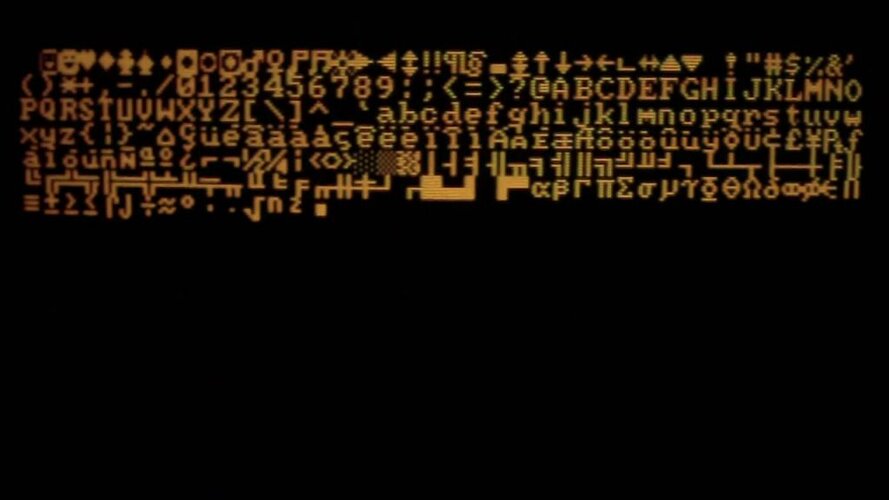
..πρεπει να γινει ετσι....
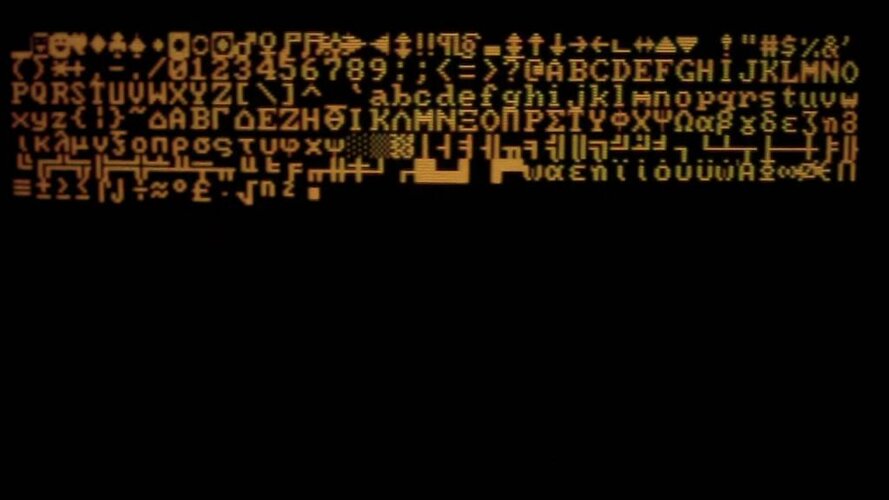
Φορτωνουμε τον χαρακτηρα:
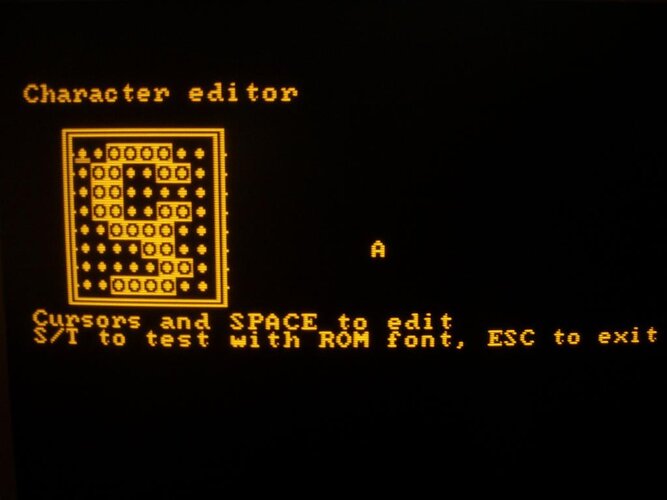
..τον τροποποιουμε..
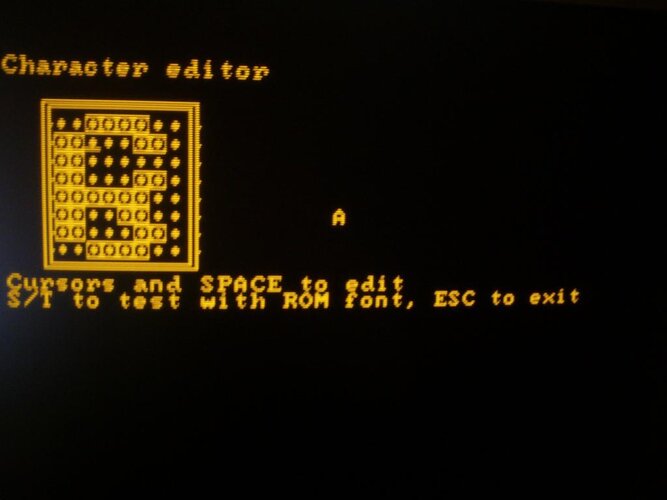
..ετοιμος...
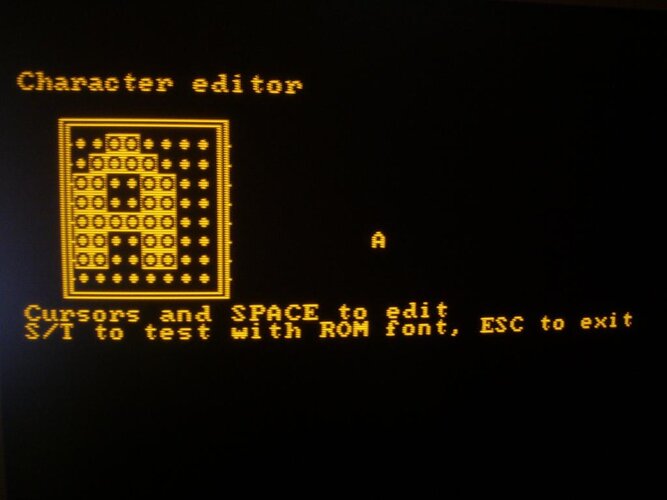
Μόλις είμαστε ικανοποιημένοι από το αποτέλεσμα το σώζουμε στην δισκέττα.
Κάνοντας αυτή την διαδικασία για όλους τους Ελληνικούς χαρακτήρες παίρνουμε στην δισκέττα το αρχείο cgafont.psf.Το μέγεθος του αρχείου μας είναι 2ΚΒ.To αρχείο όμως της CGA ROM είναι 4ΚΒ.Πως όμως θα εισαγάγουμε τους χαρακτήρες που μόλις φτιάξαμε στo αρχείο της ROM που ήδη έχουμε?H απάντηση είναι απλή (το έχουμε ξανακάνει άλλωστε):με έναν HEX Editor (στην περίπτωση μας με το Xvi32).Ωραία μέχρι εδώ…αλλά σε πιο σημείο της ROM θα μπουν οι χαρακτήρες μας? Στην αρχή, στην μέση, ή στο τέλος του αρχείου? :wait2:
Και αυτό φυσικά λύνεται δια της αρχαίας ιατρικής μεθόδου της επισκοπήσεως :ανοίγουμε ταυτόχρονα και τα 2 αρχεία ,τα βάζουμε δίπλα-διπλα και διαπιστώνουμε ότι ουσιαστικά η αρχή τους είναι ίδια (κάτι extra τετράγωνα στην αρχή του CGAFONT.PSF δεν μας απασχολούν).
:ανοίγουμε ταυτόχρονα και τα 2 αρχεία ,τα βάζουμε δίπλα-διπλα και διαπιστώνουμε ότι ουσιαστικά η αρχή τους είναι ίδια (κάτι extra τετράγωνα στην αρχή του CGAFONT.PSF δεν μας απασχολούν).
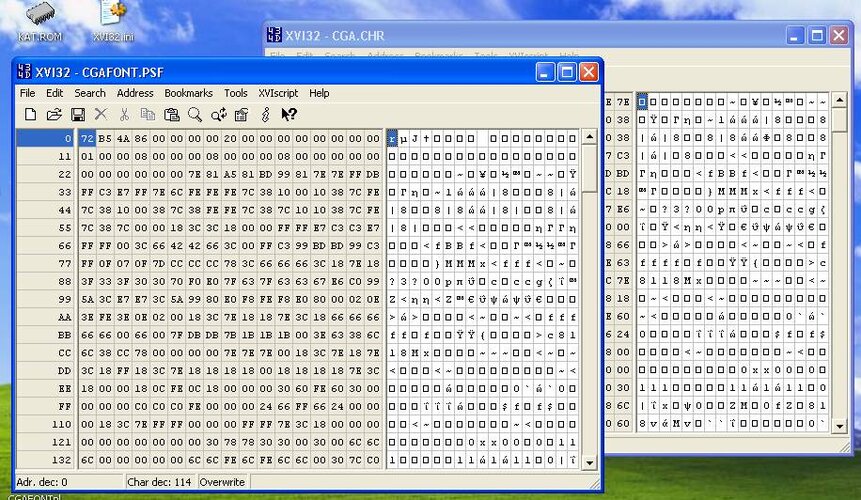
Κάνουμε λοιπόν τις απαραίτητες τροποποιήσεις με το Hex Editor μας και απολαμβάνουμε το αποτέλεσμα….
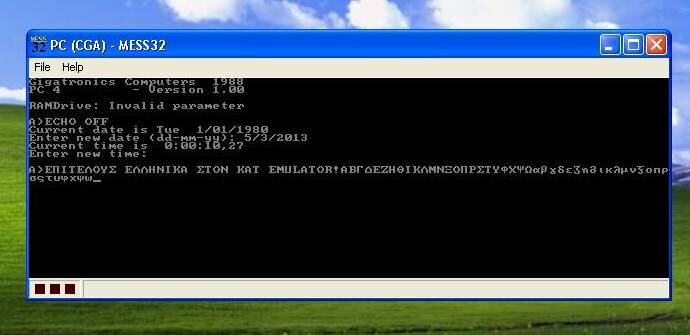
Για συγκριση βαζω και το screenshot απο τον αυθεντικο ΚΑΤ:
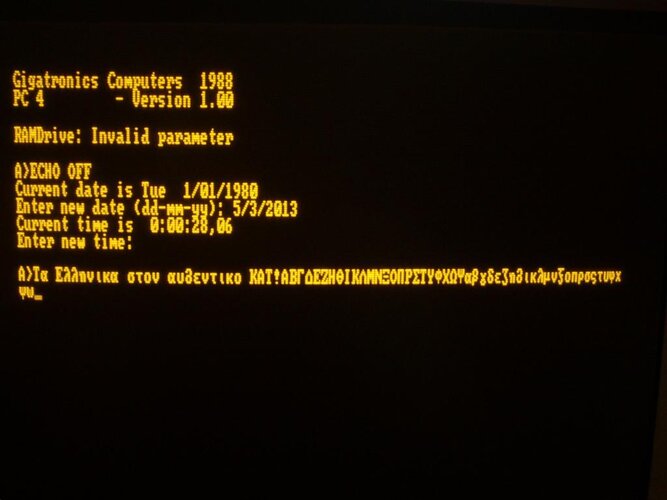
Να αναφέρω επίσης ότι η διαδικασία που κάναμε παραπάνω με το Ripfont στον ΚΑΤ μπορεί να γίνει και κατευθείαν στο windows pc μας με το πρόγραμμα HGCEdit από εδώ
http://mcbx.netne.net/fontedit/.Το βασικό όμως μειονέκτημα είναι ότι εκεί δεν μπορούμε να δούμε τους χαρακτήρες από την ROM και έτσι τους κάνουμε Ελληνικούς ,αλλά όπως νομίζουμε εμείς, και όχι με την μορφή που έχουν στην ROM του ΚΑΤ.
Μέχρι στιγμής το μόνο που δεν λειτουργεί είναι οι τονισμένοι χαρακτήρες..μπορεί να φταίει βέβαια και η buggy παλαια έκδοση του MESS που χρησιμοποιώ…
Eπομένως η μόνη επιλογή που έμενε ήταν ο hardware τρόπος, δηλ. η σύνδεση του chip σε έναν EPROM programmer…Επειδή όμως δεν τα παρατάμε εύκολα (και αφού το google είναι φίλος μας
Και επειδή έχει αρχίσει το πράγμα να γίνεται… κουλτουριάρικη ταινία, ας εξηγηθώ καλύτερα:
Πηγαίνουμε στο ακόλουθο site http://www.seasip.demon.co.uk/Unix/PSF/ripfont.html και κατεβάζουμε το προγραμματάκι Ripfont.exe.Εκτός από αυτό χρειαζόμαστε και το Graphtabl του DOS. Εγω είχα την έκδοση για DOS 3.30 η οποία όμως ΔΕΝ είναι συμβατή με το DOS 3.20:rant:..επειδη λοιπόν και οι Ρώσοι είναι φίλοι μας
Το Ripfont είναι ουσιαστικά ένας font editor.Mε το πρόγραμμα αυτό παίρνουμε έναν-έναν τους χαρακτήρες και τους τροποποιούμε ώστε να γίνουν όπως τους θέλουμε (δηλ. Ελληνικοί).Το πλεονέκτημα του προγράμματος είναι ότι όσο τροποποιούμε τον χαρακτήρα μπορούμε να τον δούμε πως είναι στην ROM ώστε να τον κάνουμε ίδιο..
To set χαρακτηρων που απο ετσι....

..πρεπει να γινει ετσι....

Φορτωνουμε τον χαρακτηρα:

..τον τροποποιουμε..

..ετοιμος...

Μόλις είμαστε ικανοποιημένοι από το αποτέλεσμα το σώζουμε στην δισκέττα.
Κάνοντας αυτή την διαδικασία για όλους τους Ελληνικούς χαρακτήρες παίρνουμε στην δισκέττα το αρχείο cgafont.psf.Το μέγεθος του αρχείου μας είναι 2ΚΒ.To αρχείο όμως της CGA ROM είναι 4ΚΒ.Πως όμως θα εισαγάγουμε τους χαρακτήρες που μόλις φτιάξαμε στo αρχείο της ROM που ήδη έχουμε?H απάντηση είναι απλή (το έχουμε ξανακάνει άλλωστε):με έναν HEX Editor (στην περίπτωση μας με το Xvi32).Ωραία μέχρι εδώ…αλλά σε πιο σημείο της ROM θα μπουν οι χαρακτήρες μας? Στην αρχή, στην μέση, ή στο τέλος του αρχείου? :wait2:
Και αυτό φυσικά λύνεται δια της αρχαίας ιατρικής μεθόδου της επισκοπήσεως

Κάνουμε λοιπόν τις απαραίτητες τροποποιήσεις με το Hex Editor μας και απολαμβάνουμε το αποτέλεσμα….

Για συγκριση βαζω και το screenshot απο τον αυθεντικο ΚΑΤ:

Να αναφέρω επίσης ότι η διαδικασία που κάναμε παραπάνω με το Ripfont στον ΚΑΤ μπορεί να γίνει και κατευθείαν στο windows pc μας με το πρόγραμμα HGCEdit από εδώ
http://mcbx.netne.net/fontedit/.Το βασικό όμως μειονέκτημα είναι ότι εκεί δεν μπορούμε να δούμε τους χαρακτήρες από την ROM και έτσι τους κάνουμε Ελληνικούς ,αλλά όπως νομίζουμε εμείς, και όχι με την μορφή που έχουν στην ROM του ΚΑΤ.
Μέχρι στιγμής το μόνο που δεν λειτουργεί είναι οι τονισμένοι χαρακτήρες..μπορεί να φταίει βέβαια και η buggy παλαια έκδοση του MESS που χρησιμοποιώ…
Τελευταία επεξεργασία από έναν συντονιστή:
angel_grig
KAT Resurrector
- Joined
- 11 Οκτ 2008
- Μηνύματα
- 3.150
- Αντιδράσεις
- 485
Ευχαριστω πολυ Ναταλι!! :thanx2: Και να μην ξεχναμε οτι εκτος απο αυτο εχουμε εκκρεμοτητα και το emulation του apple part (και φυσικα και πολλα άλλα τα οποια δουλευω ταυτοχρονα που θα αποκαλυφθουν εν καιρωKambia είπε:Μπράβο angel_grig. Περιμένουμε τώρα και τη λύση για τους τονισμένους χαρακτήρες

